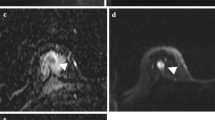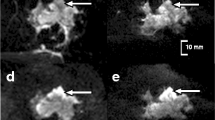Abstract
Purpose
To investigate the feasibility and effectiveness of diffusion-weighted imaging (DWI)-guided magnetic resonance spectroscopy (MRS) using readout-segmented echo-planar imaging (RS-EPI) to characterise breast lesions.
Materials and methods
A total of 258 patients with 258 suspicious breast lesions larger than 1 cm in diameter were examined using DWI-guided, single-voxel MRS with RS-EPI. The mean total choline-containing compound (tCho) signal-to-noise ratio (SNR) and concentration were used for the interpretation of MRS data. T-tests, χ2-tests, receiver operating characteristic (ROC) curve analyses and Pearson correlations were conducted for statistical analysis.
Results
Histologically, 183 lesions were malignant, and 75 lesions were benign. Both the mean tCho SNR and concentration of malignant lesions were higher than those of benign lesions (6.23 ± 3.30 AU/mL vs. 1.26 ± 1.75 AU/mL and 3.17 ± 2.03 mmol/kg vs. 0.86 ± 0.83 mmol/kg, respectively; P < 0.0001). For a tCho SNR of 2.0 AU/mL and a concentration of 1.76 mmol/kg, the corresponding areas under the ROC curves were 0.93 and 0.90, respectively. The mean tCho SNR and concentration negatively correlated with apparent diffusion coefficients calculated from RS-EPI, with correlation coefficients of −0.54 and −0.48, respectively.
Conclusion
DWI-guided MRS using RS-EPI is feasible and accurate for characterising breast lesions.
Key Points
• The mean tCho SNR and concentration negatively correlated with ADCs.
• DWI-guided MRS using RS-EPI is feasible.
• DWI-guided MRS using RS-EPI accurately characterises breast lesions.







Similar content being viewed by others
Abbreviations
- ADC:
-
Apparent diffusion coefficient
- AUC:
-
Area under the receiver operating characteristic curve
- BI-RADS:
-
Breast Imaging Reporting and Data System
- CI:
-
Confidence interval
- DCE:
-
Dynamic contrast enhancement
- DWI:
-
Diffusion-weighted imaging
- MRS:
-
Magnetic resonance spectroscopy
- ROC:
-
Receiver operating characteristic
- ROI:
-
Region of interest
- RS-EPI:
-
Readout-segmented echo-planar imaging
- SNR:
-
Signal-to-noise ratio
- SS-EPI:
-
Single-shot echo-planar imaging
- tCho:
-
Total choline-containing compounds
References
Gruber S, Debski BK, Pinker K et al (2011) Three-dimensional proton MR spectroscopic imaging at 3 T for the differentiation of benign and malignant breast lesions. Radiology 261:752–761
Dorrius MD, Pijnappel RM, van der Weide Jansen MC et al (2012) The added value of quantitative multi-voxel MR spectroscopy in breast magnetic resonance imaging. Eur Radiol 22:915–922
Bartella L, Morris EA, Dershaw DD et al (2006) Proton MR spectroscopy with choline peak as malignancy marker improves positive predictive value for breast cancer diagnosis: preliminary study. Radiology 239:686–692
Stanwell P, Gluch L, Clark D et al (2005) Specificity of choline metabolites for in vivo diagnosis of breast cancer using 1H MRS at 1.5 T. Eur Radiol 15:1037–1043
Ei Khouli RH, Jacobs MA, Mezban SD et al (2010) Diffusion-weighted imaging improves the diagnostic accuracy of conventional 3.0-T breast MR imaging. Radiology 256:64–73
Dorrius MD, Dijkstra H, Oudkerk M, Sijens PE (2014) Effect of b value and pre-admission of contrast on diagnostic accuracy of 1.5-T breast DWI: a systematic review and meta-analysis. Eur Radiol 24:2835–2847
Marini C, Iacconi C, Giannelli M, Cilotti A, Moretti M, Bartolozzi C (2007) Quantitative diffusion-weighted MR imaging in the differential diagnosis of breast lesion. Eur Radiol 17:2646–2655
Murtz P, Tsesarskiy M, Kowal A et al (2014) Diffusion-weighted magnetic resonance imaging of breast lesions: the influence of different fat-suppression techniques on quantitative measurements and their reproducibility. Eur Radiol 24:2540–2551
Baltzer PA, Dietzel M (2013) Breast lesions: diagnosis by using proton MR spectroscopy at 1.5 and 3.0 T--systematic review and meta-analysis. Radiology 267:735–746
Mizukoshi W, Kozawa E, Inoue K et al (2013) (1)H MR spectroscopy with external reference solution at 1.5 T for differentiating malignant and benign breast lesions: comparison using qualitative and quantitative approaches. Eur Radiol 23:75–83
Jacobs MA, Barker PB, Bottomley PA, Bhujwalla Z, Bluemke DA (2004) Proton magnetic resonance spectroscopic imaging of human breast cancer: a preliminary study. J Magn Reson Imaging 19:68–75
Bartella L, Thakur SB, Morris EA et al (2007) Enhancing nonmass lesions in the breast: evaluation with proton (1H) MR spectroscopy. Radiology 245:80–87
Kousi E, Tsougos I, Vasiou K et al (2012) Magnetic resonance spectroscopy of the breast at 3T: pre- and post-contrast evaluation for breast lesion characterization. ScientificWorldJournal 2012:754380
Lenkinski RE, Wang X, Elian M, Goldberg SN (2009) Interaction of gadolinium-based MR contrast agents with choline: implications for MR spectroscopy (MRS) of the breast. Magn Reson Med 61:1286–1292
Sijens PE, Oudkerk M, van Dijk P, Levendag PC, Vecht CJ (1998) 1H MR spectroscopy monitoring of changes in choline peak area and line shape after Gd-contrast administration. Magn Reson Imaging 16:1273–1280
Sijens PE, van den Bent MJ, Nowak PJ, van Dijk P, Oudkerk M (1997) 1H chemical shift imaging reveals loss of brain tumor choline signal after administration of Gd-contrast. Magn Reson Med 37:222–225
Baltzer PA, Gussew A, Dietzel M et al (2012) Effect of contrast agent on the results of in vivo (1)H MRS of breast tumors - is it clinically significant? NMR Biomed 25:67–74
Bogner W, Pinker-Domenig K, Bickel H et al (2012) Readout-segmented echo-planar imaging improves the diagnostic performance of diffusion-weighted MR breast examinations at 3.0 T. Radiology 263:64–76
Kim YJ, Kim SH, Kang BJ et al (2014) Readout-segmented echo-planar imaging in diffusion-weighted mr imaging in breast cancer: comparison with single-shot echo-planar imaging in image quality. Korean J Radiol 15:403–410
Bogner W, Pinker K, Zaric O et al (2014) Bilateral Diffusion-weighted MR Imaging of Breast Tumors with Submillimeter Resolution Using Readout-segmented Echo-planar Imaging at 7 T. Radiology. doi:10.1148/radiol.14132340:132340
Mori N, Ota H, Mugikura S et al (2014) Luminal-Type Breast Cancer: Correlation of Apparent Diffusion Coefficients with the Ki-67 Labeling Index. Radiology. doi:10.1148/radiol.14140283:140283
Choi SY, Chang YW, Park HJ, Kim HJ, Hong SS, Seo DY (2012) Correlation of the apparent diffusion coefficiency values on diffusion-weighted imaging with prognostic factors for breast cancer. Br J Radiol 85:e474–e479
Kul S, Cansu A, Alhan E, Dinc H, Gunes G, Reis A (2011) Contribution of diffusion-weighted imaging to dynamic contrast-enhanced MRI in the characterization of breast tumors. AJR Am J Roentgenol 196:210–217
Kelley DA, Wald LL, Star-Lack JM (1999) Lactate detection at 3T: compensating J coupling effects with BASING. J Magn Reson Imaging 9:732–737
Mescher M, Merkle H, Kirsch J, Garwood M, Gruetter R (1998) Simultaneous in vivo spectral editing and water suppression. NMR Biomed 11:266–272
Baik HM, Su MY, Yu H, Mehta R, Nalcioglu O (2006) Quantification of choline-containing compounds in malignant breast tumors by 1H MR spectroscopy using water as an internal reference at 1.5 T. Magma 19:96–104
Look DC, Locker DR (1970) Time saving in measurement of NMR and EPR relaxation times. Rev Sci Instrum 41:250–251
DeLong ER, DeLong DM, Clarke-Pearson DL (1988) Comparing the areas under two or more correlated receiver operating characteristic curves: a nonparametric approach. Biometrics 44:837–845
Landis JR, Koch GG (1977) The measurement of observer agreement for categorical data. Biometrics 33:159–174
Heo SH, Jeong YY, Shin SS et al (2010) Apparent diffusion coefficient value of diffusion-weighted imaging for hepatocellular carcinoma: correlation with the histologic differentiation and the expression of vascular endothelial growth factor. Korean J Radiol 11:295–303
Bakken IJ, Gribbestad IS, Singstad TE, Kvistad KA (2001) External standard method for the in vivo quantification of choline-containing compounds in breast tumors by proton MR spectroscopy at 1.5 Tesla. Magn Reson Med 46:189–192
Jansen JF, Backes WH, Nicolay K, Kooi ME (2006) 1H MR spectroscopy of the brain: absolute quantification of metabolites. Radiology 240:318–332
Acknowledgments
The scientific guarantor of this publication is FuhuaYan. The authors of this manuscript declare relationships with Siemens Shenzhen Magnetic Resonance Ltd. No complex statistical methods were necessary for this study. Institutional review board approval was obtained. Written informed consent was obtained from all subjects (patients) in this study. The study subjects and cohorts have not been previously reported. Methodology: prospective, diagnostic or prognostic study, performed at one institution.
Author information
Authors and Affiliations
Corresponding author
Rights and permissions
About this article
Cite this article
Sun, K., Chai, W., Fu, C. et al. Diffusion-Weighted Imaging-guided MR Spectroscopy in Breast Lesions using Readout-Segmented Echo-Planar Imaging. Eur Radiol 26, 1565–1574 (2016). https://doi.org/10.1007/s00330-015-4000-0
Received:
Revised:
Accepted:
Published:
Issue Date:
DOI: https://doi.org/10.1007/s00330-015-4000-0




